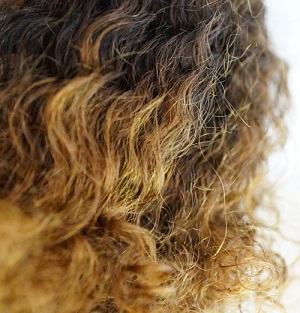Whether you have been considering colouring your curls for a while, or have just decided in the snap of a moment after looking at pictures of the hottest new celebrity looks, that you want to bleach or dye your hair, it is essential that you read this first.
You are probably aware that, like many other things in life, bleaching and dyeing is very bad for your hair. But to understand how it works, why it is bad, and how to lessen the impact, you first need to understand the basic anatomy of the hair:
Basic Hair Anatomy
The terminal part of the hair is seated within the dermis of the skin, and is called the bulb. It is nourished by small blood vessels and has a layer of actively dividing cells which keep the hair growing. The hair shaft consists of 3 layers, the cuticle; a thin, transparent protective layer which helps prevent damage, the cortex; the pigmented part, which is made up of a tough fibrous protein called keratin and provides texture and strength and finally the medulla, a layer only found in big, thick hairs.
The width, texture and structure of the hair is determined by the proteins in the hair. Curly hair is curly, and straight hair is straight because of the arrangement of the proteins within the hair.
Effect of Dyeing
Dyes strip the cuticle from your hair, leaving it weak, unprotected and prone to dryness and damage. This leads to hair loss, a lack of lustre and shine, and a course appearance. If you choose to colour your hair, you will need to use special conditioning products to strengthen and maintain your hair.
Effect of Bleaching
So, what does bleaching do and why is it bad? Like dyeing, bleaching removes the cuticle from the hair. This means that dyeing cause the same problems to arise, but it also invites additional problems, because, while dye attaches itself to the hair to give a coloured appearance, bleach strips away part of the cortex too, removing structural proteins and pigments. This leaves the hair thinner, completely lacking protection, and lighter, both in colour and weight. This can lead to lank hair that is prone to greasiness – and the worst bit for people with lush curls is that it can damage your curls!!
As said before, texture and structure are dependant on the proteins present, and thus curls are too. Bleaching removes some of these proteins, and may cause a reduction in curliness, or abolish them completely. This has never happened to me, but I have heard plenty of horror-stories from fellow curly-haired people who have reported loss of curls due to bleaching.
Colouring and Bleaching Tips
If you still want to bleach or colour your hair, there are a few rules that you should follow in order to keep your curls in mint condition.
- Dye the ends, and steer clear of the roots
- If you really must bleach, go for the ombré look (a graduated lightening effect) rather than whole-head bleaching.
- Don’t over bleach! If you have black or brown hair, wishing to attain platinum blonde hair is too much!
- Use semi-permanent dyes, as they are less harmful
- Deep condition regularly, both prior to colouring, and thereafter
- Reduce the amount of times you shampoo (shampooing is bad for your hair, so either use conditioning shampoo, or only use conditioner)
- Use wide-toothed comb or brush to reduce breakage
- Try to reduce or avoid brushing hair in its weakest state (soaking wet!). If it can’t be avoided, use a wide toothed comb to reduce damage
Pre-and Post Colouring/ Bleaching Routine
Shampoo thoroughly about 2 weeks before dyeing, and use plenty of conditioner. Condition regularly with a protein conditioner, but avoid shampooing. Deep-condition with a warm oil treatment (use extra virgin olive oil, coconut oil or castor oil) a few days before, but only use a little oil to avoid having to shampoo it out. Condition thoroughly right before you colour, then colour as the instructions state. If it must be done on dry hair, let your hair air dry (do not use heat!) then follow the procedure.
If you have coloured your hair, try to avoid washing for at least 24-48 hours to allow the colour to develop, then wash with specially formulated conditioning shampoo for coloured hair. Condition regularly, and don’t use heat.
If you have bleached your hair, rinse bleach thoroughly and use conditioning shampoo then lots of strengthening conditioner for damaged/ bleached hair. Use a strengthening conditioner on a daily basis for the next two weeks. After this, continue to use strengthening conditioner regularly as your hair requires, and leave it in for several minutes.
It is worth purchasing a good leave-in conditioner for bleached/ damaged hair, as it will save you washing time. Avoid using heat on bleached hair, and use a wide-toothed comb or brush to reduce damage.



Recent Comments